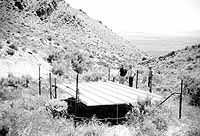| Division of Wildlife Resource officials check up on a local guzzler. These water units provide wildlife with a much needed drink during drought seasons. Birds mainly use the constructed water facility, yet many other wildlife species take advantage of the guzzler systems. Funding for such facilities come from donations and wildlife license fees. |
More than 570 man-made water sources are providing thirsty birds and animals with water in some of Utah’s harshest environments this summer. The water sources are known as guzzlers and the Division of Wildlife Resources and other agencies have been placing them on public land in Utah since the 1940’s.
“These guzzlers are always important to wildlife during the summer but with the severe drought we’re having this year, they’re vital,” explained DWR upland game coordinator Dean Mitchell.
“Water is often the major factor in how many young and adult birds and animals make it through the summer here in Utah. We’re trying to help them out by providing a water source in areas that can be extremely dry this time of year.”
Mitchell says chukar partridge and mourning doves in Utah are the game birds that use the state’s guzzlers the most. Guzzlers are also heavily used by desert bighorn sheep, pronghorn antelope and mule deer. Birds and animals that people hunt aren’t the only wildlife that benefit, however.
“There are a whole host of nongame species that benefit, including jackrabbits, small mammals, gophers and a myriad of birds,” Mitchell explains.
Mitchell says guzzlers vary in size, from 350 gallon guzzlers built for chukar partridge to guzzlers for bighorn sheep that hold as much as 10,000 gallons of water.
Regardless of their size, all guzzlers have similar features. They include an apron that collects rain and snow, a tank that stores the water and a drinking trough that supplies it to birds and animals.
The water is usually supplied by rain and snowfall, but it’s been so dry in parts of southern Utah this year that DWR personnel have had to haul water to some of the guzzlers there.
Most of Utah’s guzzlers have been built by DWR personnel in the state’s harshest environments, including the West desert and areas in southern Utah.
DWR staff place them in areas that provide good habitat and good escape cover from predators.
Guzzler costs range from $800 to $10,000, depending on their size. Most of the money for smaller guzzlers comes for Utah’s Habitat Conservation Fund. This money is provided when hunters and anglers buy a hunting or fishing license.
Money for the larger guzzlers used by bighorn sheep and other big game animals comes from the Habitat Conservation Fund and from hunters who buy conservation hunting permits.
Another big contributor to guzzlers in Utah is the Water for Wildlife Foundation, a non-profit conservation organization based in Lander, Wyoming, which provides funding for water projects to help wildlife across the country. Funding is also provided by the National Wild Turkey Federation and other conservation groups. These organizations rely on donations from members and the general public to fund guzzlers and other wildlife conservation projects.
Because of safety concerns related to overcrowding guzzler areas with hunters, and because of the sensitivity of guzzler site locations being used by wildlife, the DWR will not provide maps of guzzler site locations. The DWR does provide information about the general areas of Utah where most of the guzzlers are found, however.

